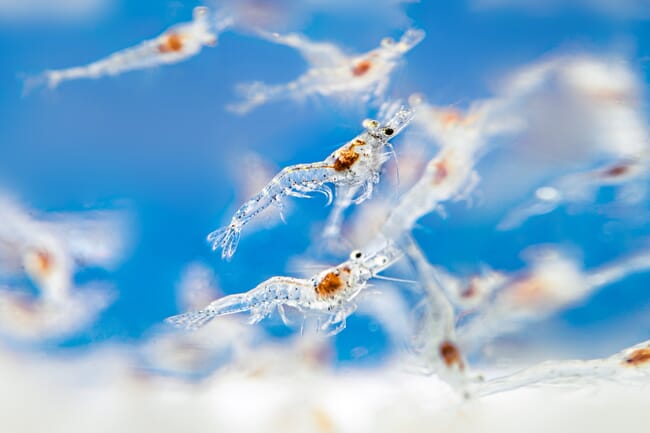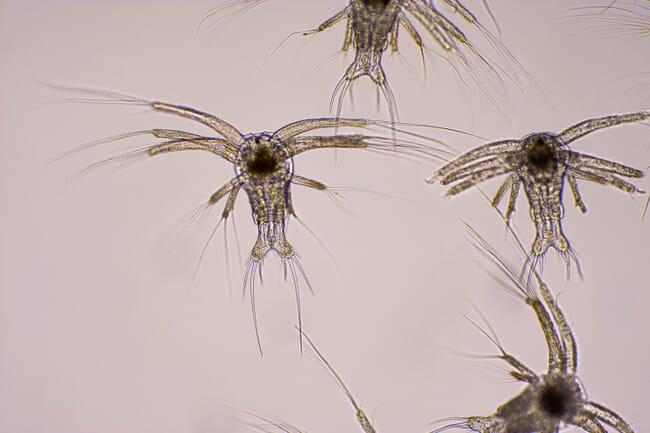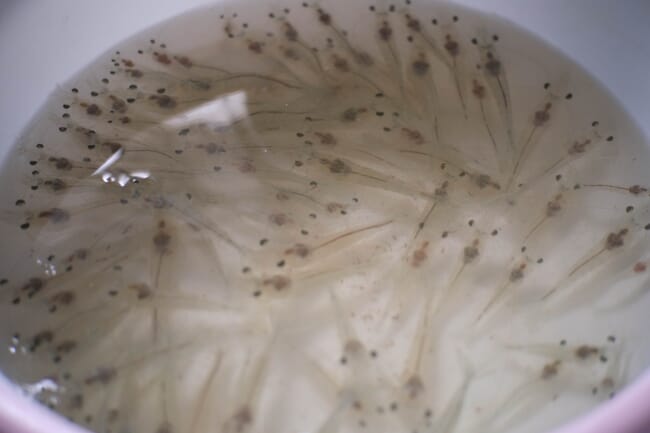
The process from egg fertilisation to ready-to-stock small shrimp is typically 12 days after final larval metamorphosis into the post-larval stage and the total time needed is normally more than one month from the time of initial broodstock readiness. Experience is a must for success, and attention to detail and timely procedures require considerable preparation.
I contacted three seasoned shrimp hatchery experts who I’ve worked with previously in order to find out what they thought were the most important points for a successful hatchery. Their answers were broadly in line with my own experience of operating a small shrimp hatchery.
Not surprisingly, the main concern in shrimp hatchery operation is maintaining biosecurity as this has proven over the years to not only to be the biggest concern due to monetary loss, but also the most devastating in terms of downtime before the production of healthy post-larvae can begin again. As most hatcheries strive to achieve specific pathogen-free (SPF) status, once a hatchery becomes affected by a devastating disease such as EMS, which is currently affecting hatcheries all over the world, mistrust often develops as well as a lengthy period of time before SPF status can be re-attained.
Biosecurity
Ewen Wilson has 22 years’ experience as a shrimp hatchery manager and worked in the second hatchery ever built in Ecuador, in 1992. I worked with Ewen in South Africa for a brief time during 2009, and when I asked him what he thought was the biggest challenge involved in operating a white shrimp (Litopenaeus vannamei) hatchery during his time in Ecuador, he stated without hesitation:
“Disease. We always had some form of disease problem – from vibriosis, to yellowhead and white spot virus – and everything in between. Securing a good source of water that can be properly filtered and sterilised is the number one priority. Also, a good source of clean freshwater is needed to maintain proper salinities for spawning and larval production, as well as to acclimate post-larvae to different pond salinities for grow-out.”
There are a number of ways to sterilise water in a practical setting. Tanks can be cleaned and sterilised with a 10 percent bleach solution. Fertilised shrimp eggs should be rinsed with clean seawater and held in 0.1 ppm iodine solution, or 100 ppm formalin, for 1 minute before being rinsed again with clean seawater and placed in a cleaned and sterilised hatching container. My experience in running a hatchery in South Africa had shown that using chlorine (20 ppm) is very effective for use in the sterilisation of seawater for the hatching of fertilised shrimp eggs.
This protocol is also effective in preparing water for shrimp nauplii. All viruses and bacteria can be killed by the addition of chlorine at a rate of 20 ppm for 24 hours. The toxicity of the residual chlorine can then effectively be eliminated with the addition of vitamin C, at a rate of 1 ppm of vitamin C per 1 ppm of chlorine (1 g vitamin C per 1000 L of water per 1 ppm of chlorine). All chlorine concentrations can be checked with a simple pool kit to ensure that seawater is free of chlorine before use. Vigorous aeration can also aid in chlorine removal.

An alternative way to prepare sterilised water to prevent bacterial contamination and infection of larval shrimp is through the use of ozone. Ozone can be applied through the use of an ozone machine delivering ozone through a venturi or, more appropriately, through the use of an extended “U” pipe or downward flow bubble contactor to better dissolve the ozone in seawater. Ozone can be measured using an oxidation redox meter (ORP) and levels at about 320 have been reported to reduce vibrio bacteria without harming larval shrimp. Care must be taken to have proper ventilation, to avoid any inhalation of ozone gas.
Ewen further stated that being able to completely disassemble hatchery pipework for sterilising by soaking for 24 hours with 500 ppm chlorine and then drying is important in preventing disease problems associated with bacteria. In other words, a clean hatchery is one that works and has the potential to be sustainable. The fertilised eggs and larval stages of shrimp are very vulnerable to problems with bacteria.
Most hatchery managers would agree with this, as shrimp diseases cause losses in excess of US$ 1 billion per year. Hatchery personnel I have known over the years would relate to me continually the difficulty in preventing a reoccurrence of disease once it entered a hatchery, so tight biosecurity is a must – as the number one way disease is transferred in the shrimp aquaculture industry is through infected tissue that can be found in an incoming water source. Producers of other species state this emphatically too, adding that biosecurity with complete vertical integration separates economically viable projects from failures.
Feeds
Manuel Dominguez is an experienced shrimp hatchery supervisor in Panama. His main concern when discussing the important points of hatchery success involves feeds.
“You have to have the best feeds for broodstock preparation for spawning, as well as for proper larval development during each stage – from mysis to post-larvae,” he says.
My own experience would again concur with this, as mature female shrimp need a varied and complete diet to lay down proper energy stores, which in turn results in viable eggs that can be fertilised, and therefore a high hatch rate. Specially prepared maturation feeds – as well as fresh squid, mussels and disease-free bloodworms – are often used to ensure the best possible nutrition for egg developing females.
In order to ensure good survival during the development of larvae from one stage to the next, the right feeds at precise concentrations must be available at the right time. Without attention to detail regarding this, failure of a shrimp hatchery is guaranteed. Typically for larval stages, there must be exact algal densities which change with the increase in size of shrimp and the advancement of the larval stages, as nutritional requirements change. A variety of maturation and larval feeds are readily available from specialised feed manufacturing companies, such as Zeigler.

Gabriel Vergara, a hatchery manager from Ecuador, who has six years’ experience working in shrimp hatcheries and laboratories, emphasises the design and location of a hatchery as the most important factors for success. Gabriel works for Empagran, the company that has pioneered L. vannamei recirculating maturation systems, and has been involved in shrimp hatchery operations for over 20 years in Ecuador, Columbia and Panama.
“The hatchery needs to be located away from rivers and on the beach, so that you can have continual access to full strength sea water. There needs to be room for an increase in production, adequate biosecurity present and access to good roads, water and electric in order to supply customers with good quality post-larvae,” he says.
Not surprisingly, Gabriel also states that proper nutrition of larvae using the right type and quantity of algae and artemia for larval production is also very important. Algae labs use sterilised water produced through the use of an autoclave to prevent bacterial contamination, while recently hatched artemia nauplii used to feed larval shrimp can be disinfected as previously described.
Conclusions
Hatchery managers and supervisors base their priorities for ensuring a successful shrimp hatchery on personal experience. Attention to disease prevention, attention to diet for broodstock and all larval development and post-larval stages, and proper design and layout of a hatchery are all of great importance for anyone engaging in shrimp hatchery production.
Further information regarding biosecurity and the prevention of disease in aquaculture, as well as a variety of other important and relevant aquaculture topics, can be learned from my “Basics of Aquaculture” course, which can be found on my website.

